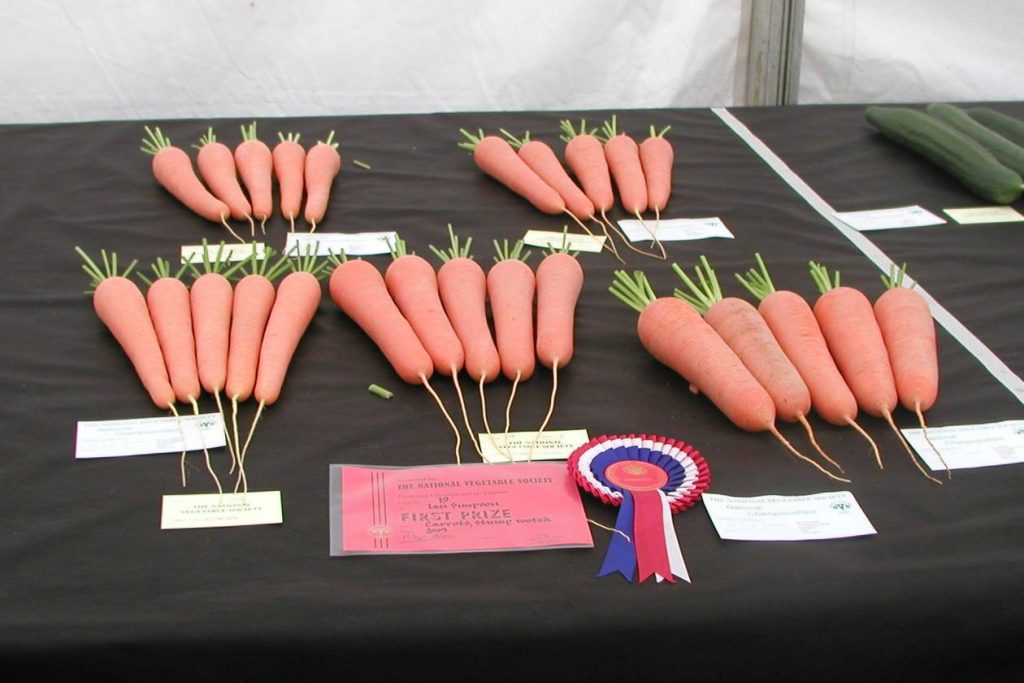
John Trim
Show grower John Trim has won the national championship with his carrots. In this article on growing stump rooted carrots (normal size!) for show, he reveals the secrets of what variety, where to grow and compost mixes for stump rooted carrots for exhibition to get you the winner’s red card at the show.
This is part 1 of a 2 part series of articles on growing prize winning stump carrots for the show bench by John Trim, Fellow of the National Vegetable Society, show judge and horticultural lecturer.
- Growing Stump Rooted Carrots for Show – Preparation
- Growing Stump Rooted Carrots for Show – Cultivation to Showing
If you intend to exhibit your carrots in a show run under National Vegetable Society or Royal Horticultural Society rules, then it is imperative that you use a strain of carrot that ends in a definite stump. In village shows carrots that do not have a decided stump may be accepted but will be down pointed.
What Variety of Carrot to Grow For Show?
Many years ago I had my first ever national win with stump rooted carrots. The variety I used then was Chantenay Red Cored Favourite. This variety has a lovely wedge shape that makes it stand out on the show bench. It is still available and well grown it still wins at top shows. The only problem is that as an open pollinated variety it is not quite as uniform in growth as an F.1 carrot, you need to grow quite a lot in order to pull a matched set. Currently the variety ‘Sweet Candle’ is winning at all the top shows.
Raised Bed Growing Stump Rooted Carrots
I grow my stump rooted carrots in a raised bed filled with sharp sand. The bed is constructed from scaffold boards 4 metres long, 1.2 metres wide and 50 centimetres high. The boards are screwed to corner posts and set up on a single layer of bricks to keep the boards clear of the soil. The boards are treated with a wood preservative and to further prevent rot the interior of the boards is lined with black and white plastic, the white side showing inwards.
The sand I use is from a quarry. Do not use beach sand as it contains salt which at a high level of concentration is detrimental to the growth of the carrots.
It is best if you can construct your carrot bed in the autumn and leave it to settle over winter. Exposure to the rain will wash out any impurities that may be in the sand. It will take approximately 4 cubic yards of sand to fill the bed.
The Carrot Growing Compost Mix
This is the recipe that has given stump carrot champion Ian Simpson several NVS National wins in the last few years.
Mix up the compost at least one month before use. Store in plastic 100 litre bags then give 2 gallons of water to each bag. Tie up the necks and store till required. The mixture is made up as follows. If you are in any doubt as to what constitutes 1 gallon by volume, buy a 2 gallon bucket from a hardware store to make measuring easier.
- 4 gallons of sieved sphagnum moss peat
- 1 gallons of silver sand
- 1 gallon of sieved sterilized top soil
- 1 gallon of fine vermiculite.
To the above add the following and mix well.
- 2oz/60 grams of dolomite lime
- 2oz/60 grams of powdered calcified seaweed
- 1oz/40 grams of Superphosphate
- 1oz/40 grams of Sulphate of Potash
Then put through a garden shredder to remove any lumps in the compost.
If that seems too complicated good results can be had by using Levingtons F2s compost with the addition of the above fertilisers.
Making the Boreholes for Your Stump Rooted Show Carrots
If the sand in the bed is dry give a good watering a few days before drilling the boreholes. Otherwise you may find your boreholes collapse before you can fill them with compost. A moist bed will make the job much easier.
Fill each hole with the prepared compost and gently tamp down to exclude any air pockets. Complete each hole before boring the next. If you don’t you may alter the form of the hole you have just bored. So don’t rush the job, finish one hole before starting the next.
The next article covers sowing, cultivation and showing your carrots Growing Stump Rooted Carrots For Show – Cultivation to Show
Growing Carrots for Show Articles by John Trim
- Growing Long Carrots for Show – Long Rooted Carrots
- Growing Stump Rooted Carrots for Show – Preparation
- Growing Stump Rooted Carrots for Show – Cultivation to Showing




